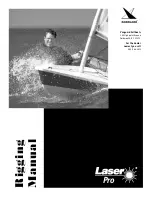
sailing performance is good enough for you to beat against the wind in normal h n d i -
tions. You can sail around 70 degrees from the wind. But to turn through the eye of
the wind is almost impossible. Instead
it
is necessary to turn with the wind
-
a
con-
trolled gybe. With the wind from the side or from astern the boat performs fairly well.
In a ten knot wind the speed is around 4 knots and in a fresher wind she sails still
faster. O n long cruises, especially in open water, the sails certainly add safety be-
cause they give the possibility if need be to maintain a course and avoid drifting down
onto a lee shore.
Fitting the rigging details
Sheet tracks and fittings for shrouds, stays and main sheet need holes according to
the drawing (fig.
37).
Fittings through foredeck and aft cabin top must be made water-
tight with elastic putty. When nuts have been tightened (do not forget washers) lock
them through deforming the threads with a chisel or something similar.
A t the mast step the deck has to be strengthened to be able to stand up to the pres-
sure. Bore
6
holes according to the drawing (diametre
3/4''- l'')
through the outer
layer of the deck. Remove the Divinycell (core material) in and around the holes and
,
fill with a two-part polyester putty to get a pressure-proof filling.
Between the top wooden chock and the deck an elastic filler should be used. The
strengthening knee below the deck is fastened with two bolts through the glassfibre
"bulkhead" with a mahogany "washer" on the outside. The stainless steel mast step
is fastened with wood screws. A
10 mm diametre hole is bored through deck and
wooden chocks to take the electric cable to the mast light.
A
plastic tube is fitted
watertight in the hole with elastic putty, the upper end at least 1/2 inch above deck.
Through this tube the cable is lead from the electrical connection (aft of toilet) up
above deck and fitted with suitable connectors for the cable in the mast.
Riggning
(See fig.
36)
The standing and running rigging are labelled. The rigging procedure is as follows:
1.
Place the mast on two boxes or trestles.
2.
The soft eye on the jib halyard, the end without the snapshackle, is put through
the jib halyard block. The rope tail is then attached to the wire halyard so that the
30
www.jonesboatyard.co.uk



































